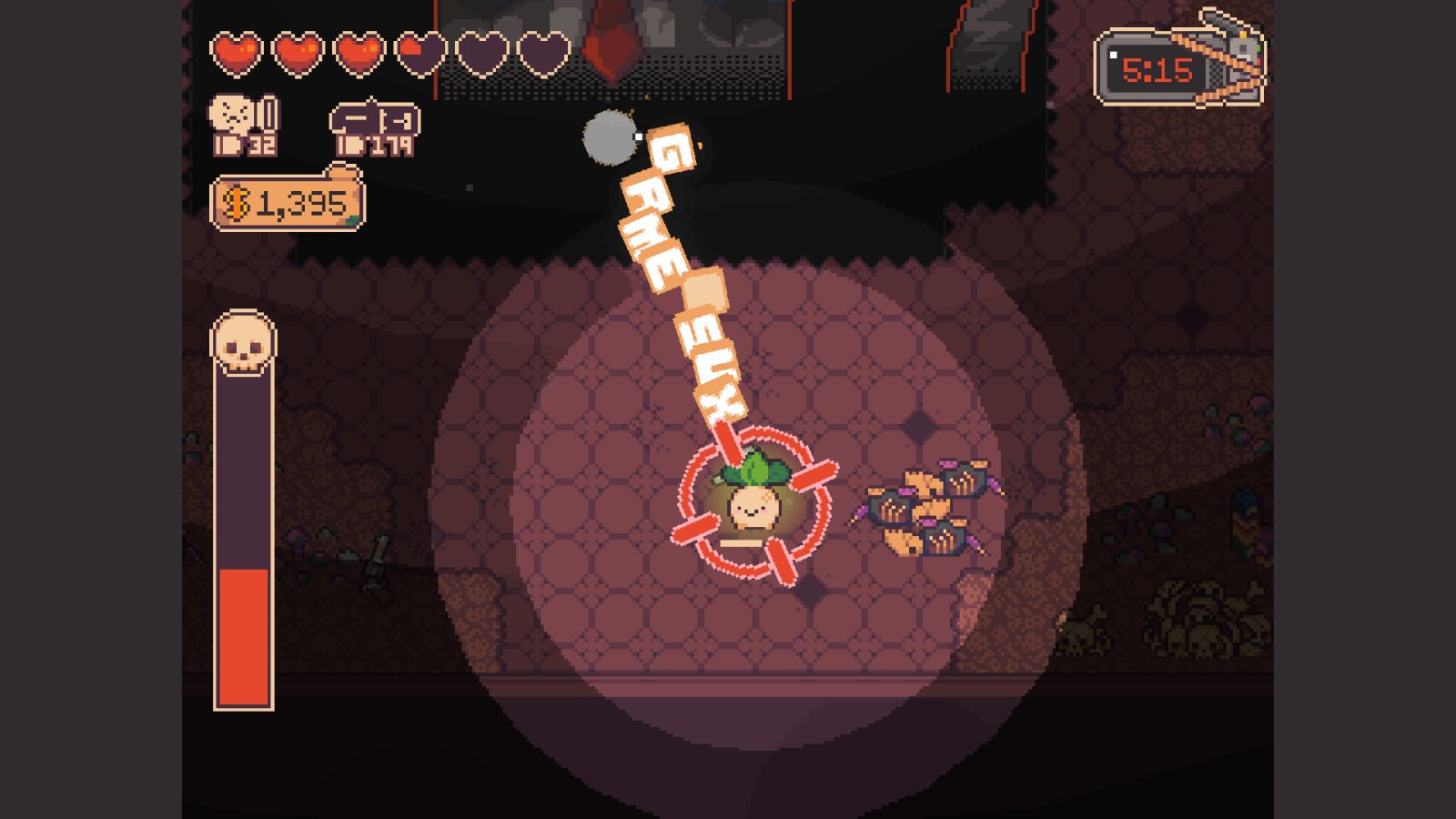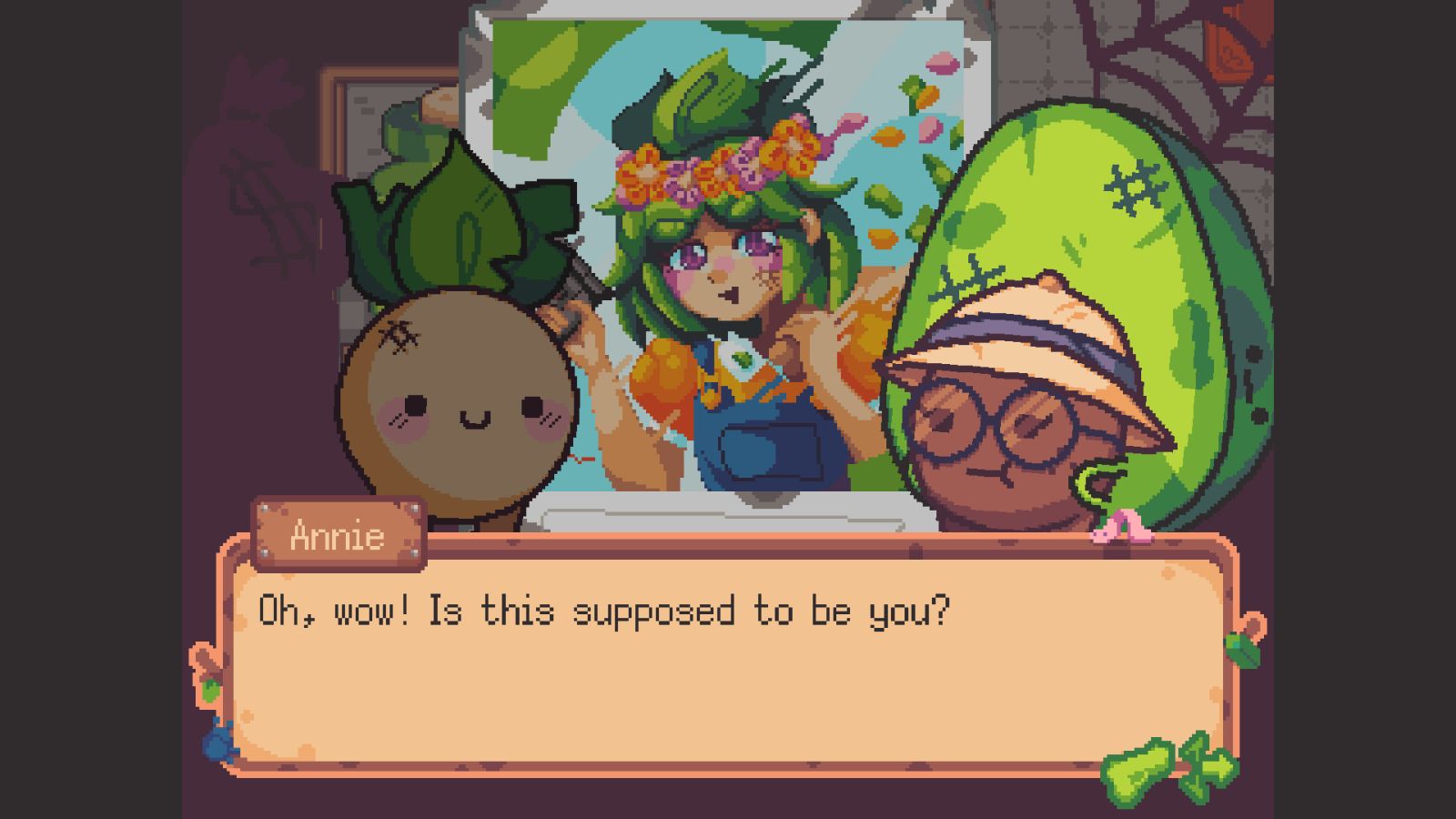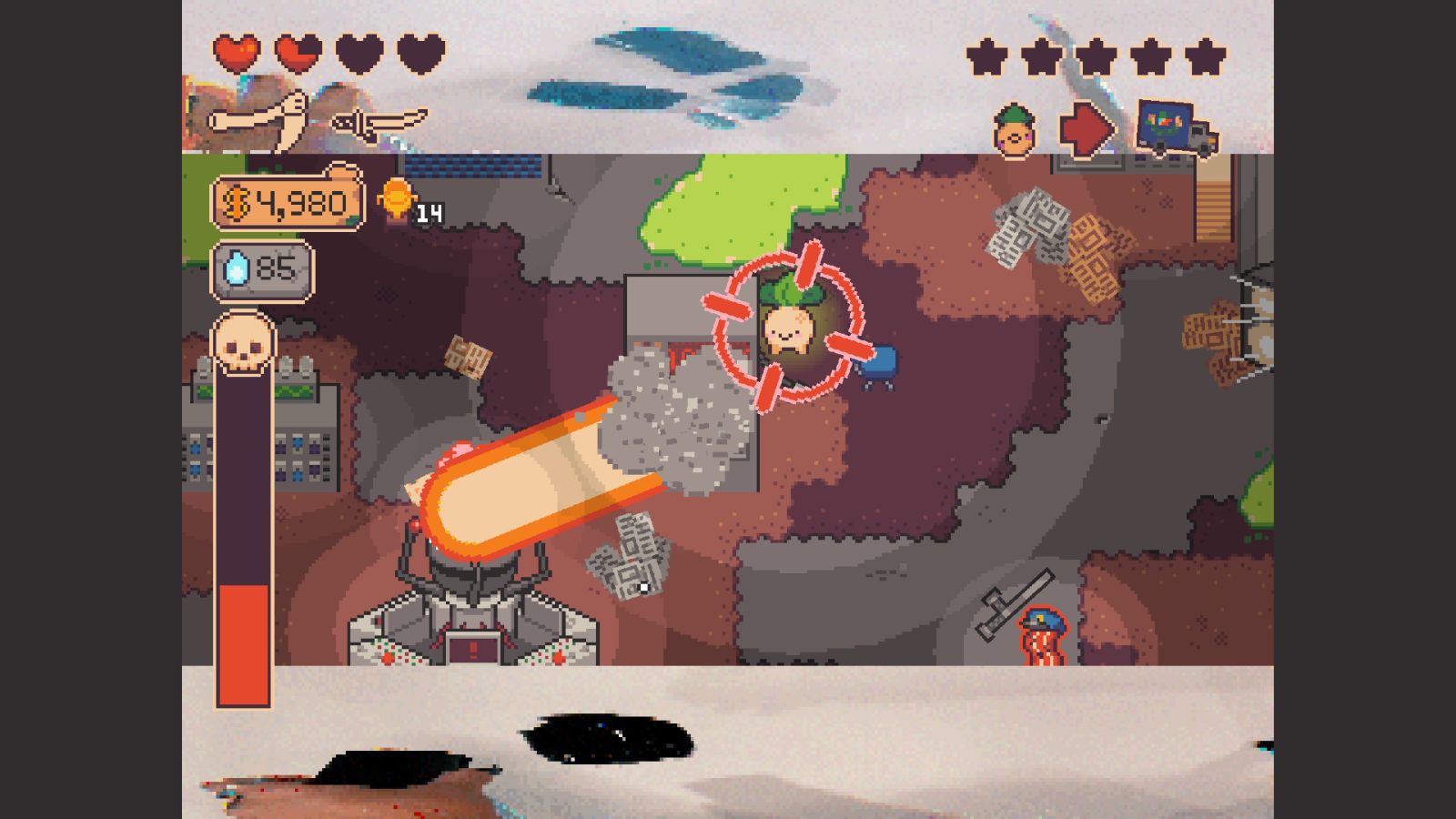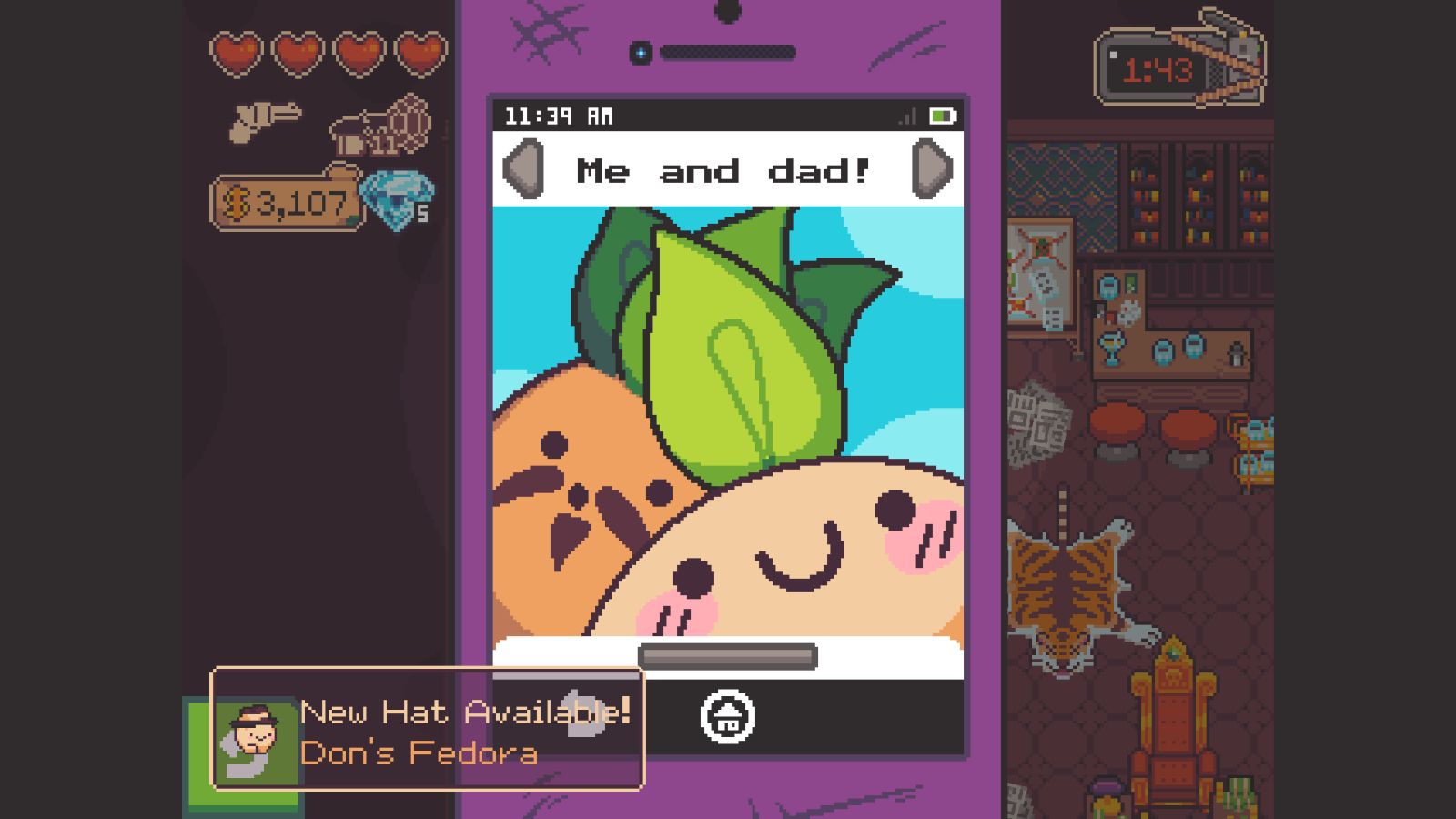In the realm of video games, there exists a certain echelon of protagonists that ring fear in the heart of their enemies. They may not be the most talkative, but they don’t need to be, as their actions speak for them. You know the like; Doomguy, Master Chief, and of course, Turnip Boy. We’re back at it again with our favorite chaotic neutral root vegetable in this action adventure rogue-lite by the devs at Snoozy Kazoo. The previous entry to the series, Turnip Boy Commits Tax Evasion, left lingering questions about the game’s world. That being said, this review will contain some spoilers for the first game, so if you’re fine with that, then buckle up!
The game starts soon after the events of the Tax Evasion plot line. The Tax God burns in the distance, and you’re contacted by Dillitini of the Pickled Gang, who you might have helped escape in the first game. This is a rather significant development given Turnip Boy’s family history. From here on out, you collaborate to rob a bank, but not just any bank, a botanical bank. After the Tax God crashed down to Earth, war broke out, and now people are taking refuge in the very establishment you’re set to rob.
The bank is sprawling, and in order to explore all of it, you need to defeat bosses to gain key cards to access new areas. You’ll run into some familiar faces along the way, and find the continuations and consequences of many stories you participated in during the first game. This extends to your team as well, Annie the scientist takes the archetypal role of the team hacker. Of course, there’s new faces too, like Stinky, the onion who owns the bank. Helping (or doing whatever Turnip Boy thinks is helping) all of the citizens of the bank leads to some peak comedy, arguably the first game’s strongest trait. Most of the laughs still stem from the joyous husk that is Turnip Boy and his irreverent actions. At one point I just traumatized an artistic cranberry so badly I think I just created the next Junji Ito.
On the other hand, there’s a certain lack of feral charm that the first game had. There’s no equivalent to tearing up every document or paper with the word “tax” on it regardless of context. There’s no accidentally irradiating someone then murdering them without a care in the world. It feels somewhat sterile compared to the first game. You’re moreso living out the results of all your actions rather than creating new ones.
One limiting factor for exploration is the time limit on individual runs. You see, this game is part rogue-lite, so every time you delve into the bank is a new run. It always starts with the Pickle Gang’s van crashing through the walls of the bank. From there you have a few minutes to do what you please, I.E.: gain money, complete side quests, or progress the main story, but eventually you have to dip. Once the timer ticks to zero, cops start flooding in and you’re faced with a heat system, where the pressure gradually increases until Stinky fills the bank with toxic gas. You have two methods of escape, either take the van back out, or find a train and buy a ticket. The bank isn’t randomized, so it’s pretty easy to find trains once you’re deep and the vault and too far from the van, but the cost of a ticket is the trade off.
Once you choose your method of escape, you return to the hideout. Here you can talk to the crew and purchase various upgrades. Dilitini will progress the main quest, Annie has a side quest requiring you to take selfies at points of interest, and Rafael will sell you permanent upgrades. The upgrades the former IRS agent sells you offer powerful benefits such as increasing the bank timer, making your guns hit harder, or even giving you a shot at higher level weapons, which are absurdly powerful. What’s even better is that Rafael is a complete himbo, so most of the upgrades are gym themed. There’s also a separate market called the dark web, but most of those items are for quest progression or give you more ways to get money.
Besides character interactions, there are the obvious actions to take in a bank. You know, pilfering. So what methods are at your disposal for bank robbery? Well, you can find statues, break into vaults, grab from displays, and rob poeple directly. Turnip Boy shakes people down by literally picking them up, turning them upside down, and shaking them. Each of these actions has an animation tied to it, most are skippable, and all of them briefly pause the police timer while they play out. It’s comical, it’s fun, and it respects the player’s time. It’s important to note that there are two kinds of valuables in the bank. The first is cash, and you can only carry a certain amount. The others are objects of worth, and these are counted separately and then added onto your total at the end of a run. It’s usually worth it to go the extra mile in exploration, as you can find a lot of valuables that way.
Naturally, there’s more than one reason to look around in an action adventure game. While exploring, you might come across an elevator that takes you to a special room. The room that the elevator leads to is randomized at the start of each run, but you can tell by the symbol on the door. One elevator might take you to a side quest to supply a man with pet rocks. Another elevator might take you to a room where a bonfire gives you a scythe and tells you to steal people’s souls in exchange for fire tracks. My personal favorite is the elevator that took me to a hidden fungus cult that’s growing in popularity in the bank.
One of the most memorable features of the bank is the boss fights. There’s four in total, and they’re all pretty good. The boss dialogue is constantly funny, and each area feels completely different in tone. At one point another one of the IRS agents shows up as a boss, and starts throwing slime videos onto the screen to keep you engaged while blasting you with a laser. They’re short, but sweet. That is… until the end game.
The ending is oddly paced. It’s a boss gauntlet, but it doesn’t do you the favor of putting them all in one place. You have to return to the four bosses you already fought, and fight them again, all on separate corners of the map. This would be fine, especially since the end game weapons are so powerful and the bosses are pretty easy, but three out of four of them have phases where they’re invincible while you fight adds, so it feels like a chore.
Then begins the second half. You have to backtrack to the boss rooms again after you’ve left, all while being hunted by a new boss. The layout has been altered to make it harder to navigate, and there’s debris in your path, slowing you down and making you more susceptible to attacks. This part is much harder than the first, but it probably wouldn’t be if the player had time to understand the telegraphing of the new boss. A third of the time I didn’t know what hit me. Other times I would get stuck in the small hallways, sandwiched between an enemy and the bosses’ attacks.
If you die at any point you have to restart the whole process, including the boss gauntlet. At one point the game bugged out on me, and didn’t give me the option to progress after I defeated three out of four of them, and I had to restart. Another time I died after getting hit immediately after dialogue. It was just a mess in my experience, and it makes what were once fun little quirks of each boss feel annoying.
This section felt like padding, which comes across as insecure when they throw in a gun that fires bullets that say, “bad game, game too short, game sucks,” over and over. The first game’s ending boss fight felt like a test of everything I had learned and been given over the course of the game, this one felt like a test of my patience.
At the same time, the music for the final stretch was great, it’s got a punchy, bubbly vocoloid charm that fueled my mad dash through the dilapidated bank. To be frank the game’s music in general was top tier. The soundtrack can be played in game on Turnip Boy’s phone, and it can even be shuffled. If you were expecting a quality selection of absolute bops, then you expected correctly.
On the note of the ending, something felt incomplete. I was hoping for more lore regarding the world Turnip Boy inhabits. The first game excelled at laying out clues about what had happened in the past, but never outright says it. This game promised more answers, but seemed to veer into the direction of Turnip Boy’s family history. That’s fine, but I’m still curious about the broader setting. I really hope they make this series a trilogy or greater to develop the world a little more.
Overall, if you loved the first game in the Turnip Boy saga, then I would highly recommend Turnip Boy Robs A Bank. It’s clear they understood what fans loved about the first game, subversive comedy, funny character interactions, and a short but sweet story. While the game fell a little flat towards the end for me, Turnip Boy Robs A Bank is a successful foray into the roguelite genre while keeping the game’s charm intact.























